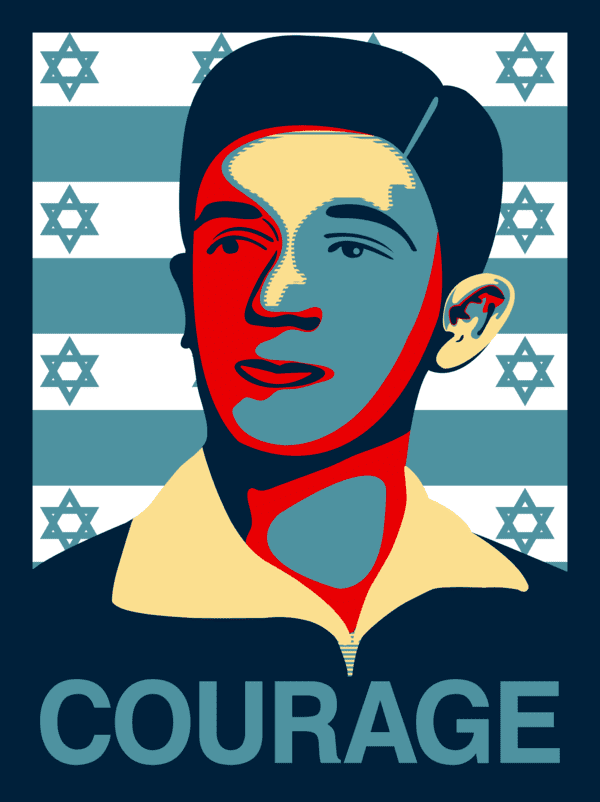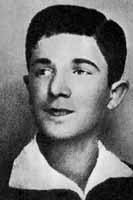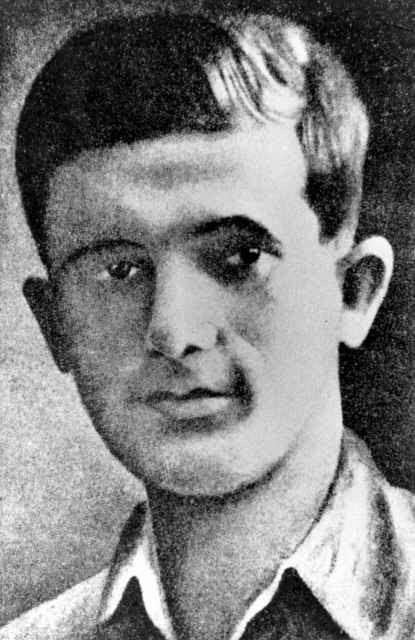Rank Commander | Name Mordechai Anielewicz | |
Nickname(s) "Little Angel" (Aniolek) Awards Cross of ValourCross of Grunwald, 3rd class Allegiance Jewish Combat Organization Similar People | ||
Mordechai anielewicz
Mordechai Anielewicz (Hebrew: מרדכי אנילביץ'; 1919 – 8 May 1943) was the leader of the Jewish Fighting Organization (Polish: Żydowska Organizacja Bojowa, ŻOB), which led the Warsaw Ghetto Uprising; the largest Jewish insurrection during the Second World War, which inspired further rebellions in both ghettos and extermination camps. His character was engraved as a symbol of courage and sacrifice, and to this day his image represents Jewish resistance during the Holocaust.
Contents
- Mordechai anielewicz
- Holocaust memorial song Mordechai Anielewicz competition
- Biography
- World War II
- Initial resistance
- Warsaw Ghetto Uprising
- Legacy
- References

Holocaust memorial song - Mordechai Anielewicz competition
Biography

Mordechai Anielewicz was born into a poor Jewish family, to Avraham and Cirel Anielewicz in the small town of Wyszków (Vishkov), near Warsaw during the reconstitution of sovereign Poland. Shortly after Mordechai's birth, his family moved to Warsaw, hoping to improve their economic situation. In Warsaw the family expanded, and Mordechai had a brother and two sisters: Pinchas, Hava and Frida. He spent his childhood in the Powisla quarter near the Vistula river, which was known as a crime-ridden slum.

Anielewicz's family suffered constant poverty, and the situation at home often reached the point of hunger. In addition, the children of the family were forced to deal with constant anti-semitism. Already then, Mordechai stood out as a leader when, along with his younger brother Pinhcas, he led a group of children who were not afraid to defend themselves against Polish children. Growing up he spent a lot of time wrestling and boxing.

At the age of 14, Mordechai joined the Betar youth movement. However, less than two years later, he switched over to the left-leaning Hashomer Hatzair. Anielewicz insisted on the study of Hebrew, and emphasized Zionist awareness. When he was 18 he went to a pre-military Polish training camp. At the beginning of the training, a group of Polish soldiers stole the weapons of the Jewish trainees, in order to prove that Jews can not be good soldiers. Anielewicz organized his Jewish comrades to return the rifles and beat the thieves. At the end of the affair he was removed from the training camp, despite the camp commander admitting that the Jews had acted properly.
World War II

On September 7th, 1939, a week after the German invasion of Poland, Anielewicz escaped with a group from Warsaw to the east of the country in the hopes that the Polish Army would slow down the German advance. When the Soviet Red Army invaded and then occupied Eastern Poland in accordance with the Molotov–Ribbentrop Pact, Anielewicz heard that Jewish refugees, other youth movement members and political groups had flocked to Wilno, which was then under Soviet control.
Anielewicz travelled to Wilno and attempted to convince his colleagues to send people back to German occupied Poland to continue the fight against the German Nazis. He then attempted to cross the Romanian border in order to open a route for young Jews to get to the Mandate of Palestine, but was caught and thrown into the Soviet jail. He was released a short time later, and returned to Warsaw in January 1940 with his girlfriend, Mira Fuchrer. While there Anielewicz saw his father for the last time, who was pressed into forced labor.
Initial resistance
After returning to Warsaw, Anielewicz organized groups, meetings, seminars, secretly attended resistance groups in other cities, and founded the underground newspaper Neged ha-zerem (Hebrew: נגד הזרם, literally "Counter-current"). At the beginning of April 1940, the construction of the Warsaw Ghetto began. It stretched over an area of 3.4 km², and gradually a 3 m high wall with barbed wire was built around it. In mid-October, it was officially established, and by mid-November the Germans had driven the Jews from the rest of Warsaw and its surroundings. An estimated 400,000 Jews, representing about 30% of all the city's population, were pushed into an area which took up approximately 2.4% of the city's area. On top of extreme overcrowding, inadequate food supply and disease caused tens of thousands of deaths before deportation even began. In October 1941, the German occupation administration in Poland issued a decree that every Jew, captured outside the ghetto without a valid permit, would be executed.
After the first reports of the mass murder of the Jews spread at the end of 1941, Anielewicz began immediately to organize defensive Jewish groups in the Warsaw Ghetto. His first attempt to join the Polish resistance, subject to the Polish exile government in London, ended in failure. In March 1942, Anielewicz was among the founders of the anti-fascist group. Even it did not have a long duration and eventually it was dissolved.
In the summer of 1942, he visited the southwest region of Poland – annexed to Germany – attempting to organize armed resistance. At the same time German authorities launched an operation which aimed at the liquidation of Jews from the Warsaw Ghetto into extermination camps. It was announced that 6,000 Jews were to be dispatched each day, irrespective of gender or age, to leave for labor camps to the east in the resettlement program. The first one set off on July 22, 1942, the eve of the Jewish holiday of Tisha B'Av, which is the saddest day of Jewish history. By September 12, 1942, German authorities from the Warsaw Ghetto deported 300,000 Jews. A total of 265,000 of them went to Treblinka where they were murdered. More than 10,000 Jews were murdered by the Germans during deportations and 11,850 Jews were sent by authorities to forced labor camps. After the first wave of deportations in mid-September 1942, roughly 55 to 60 thousand Jews remained in the ghetto.
Warsaw Ghetto Uprising
In October 1942, the Jewish Marine Corps managed to establish contact with the Polish Land Army, which was able to smuggle a small amount of weapons and explosives into the ghetto. Since the end of September 1942, the Jews started building fortified bunkers and shelters in the Warsaw Ghetto, and there were 600 by January 1943. Each fighter had a gun and several hand grenades (many of them home-made) or molotov cocktails. There was however a lack of ammunition and heavier weapons - only a few rifles, ground mines, and one machine gun were available.
On January 18, 1943, the Germans resumed deportation. Anielewicz, together with other members of ŻOB and ŻZW, decided to act. Twelve of them joined a group of evacuated Jews, and attacked the German soldiers on the contracted signal. In the subsequent confusion, part of the deported Jews managed to escape. Most of the resistance in the attack died. Anielewicz, who commanded the operation, managed to escape. This first case of armed resistance was of great importance. Among other things, it led to the greater willingness of the Polish underground to provide weapons to the Jewish resistance. Not all weapons, however, came from underground groups. Some of them ŻOB bought from arms dealers. The beginning of the revolt was a prelude to the Warsaw Ghetto Uprising that commenced on April 19th. During these three months, Anielewicz's leadership underwent intensive preparations for further clash with the Germans. He decided to use the guerrilla way of fighting with a vast network of tunnels, bunkers, roofs and surprise moments. He believed that enough Jews could withstand the ghetto for months. A day after the Germans suspended deportations, he wrote an open letter to the people of the ghetto on the name of the Jewish Battle Organization:
To the Jewish Masses in the GhettoOn January 22, 1943, six months will have passed since the deportations from Warsaw began. We all remember well the days of terror during which 300,000 of our brothers and sisters were cruelly put to death in the death camp of Treblinka. Six months have passed of life in constant fear of death, not knowing what the next day may bring. We have received information from all sides about the destruction of the Jews in the Government-General, in Germany, in the occupied territories. When we listen to this bitter news we wait for our own hour to come, every day and every moment. Today we must understand that the Nazi murderers have let us live only because they want to make use of our capacity to work to our last drop of blood and sweat, to our last breath. We are slaves, and when slaves are no longer profitable, they are killed. Everyone among us must understand that, and everyone among us must remember it always.
The final destruction of the ghetto and deportation of the remaining Jews began on April 19th, at 6 AM, the day before Adolf Hitler's birthday and Passover. SS functionary Ferdinand von Sammern-Frankenegg sent 850 soldiers (German and Ukrainian) to Warsaw with sixteen officers who accompanied a light tank and two armored cars. Members of Jewish resistance groups attacked groups of German soldiers with pistols, grenades, and Molotov cocktails from roofs, balconies, windows, doors and adjoining courtyards. Although the Germans had military superiority, they were not prepared whatsoever for the guerrilla way of fighting they had encountered. On the contrary, Jews had a perfect knowledge of the enviornment, relied on a number of hiding places, and were difficult to target because of the interconnection of individual houses. After two hours of intense fighting, the Germans withdrew.
At 11 AM the next morning, soldiers under the command of SS General Jürgen Stroop entered the ghetto, where again they encountered hard resistance from approximately 750 Jewish defenders. Stroop set up artillery and sent soldiers to look for the hiding Jews. In the afternoon of the same day, there was a symbolic event where two Jewish boys climbed to the roof of one of the houses where they put Polish and Jewish flags. Both of them were in the eye of not only to Stroop, but also Himmler. On the evening of the first day, Stroop withdrew his man.
During the following days, the Germans managed to break the tough resistance with the use of artillery and flame throwers. The smoke and heat from the fire forced a number of Jews to leave their shelters, and some chose to commit suicide by jumping from the windows of burning houses, or they managed to escape through the sewage lines that were still connected to the Gentile part of the city after the construction of the ghetto. On the third day of the collision, Stroop changed tactics and tried to avoid direct confrontation to reduce the number of German losses. After over four days of fighting, the Jewish Headquarters in Muranów fell. Most of the defenders were dead or wounded, and many escaped outside the ghetto.
On April 23, a bunker was built under the house in Miła Street. Until April 25th, the Germans managed to capture 25,500 Jews. At the end of the month, many bunkers and hiding places were exposed and most homes were burned to the ground. On May 7th, a group led by Zivia Lubetkin set out from the Command Bunkhouse under the Miła Street through a complex sewer system to find an escape route from the ghetto. A day later, however, the bunker was discovered by the Germans - at that time, there were three hundred people, including Anielewicz and his girlfriend, and others there. German soldiers fired into the fortified headquarters with gas hoses to expel the hiding Jewish fighters to the surface. From the bunker, only a handful of them managed to penetrate the sewer network. Others, like Anielewicz, died either by gas poisoning or by suicide to avoid capture.
Several days before the final suppression of the rebellion and shortly after the destruction of the Command Bunk, a rescue operation was carried out, during which about eighty Jewish fighters were transferred to a so-called Aryan section of the city and taken to safety. The event was organized by Yitzhak Zuckerman and Simcha Rotem. Although the Germans planned to destroy the ghetto within three days, the struggles lasted for four weeks and they didn't manage to suppress them definitively until May 16, 1943, when Operation Commander Jürgen Stroop symbolically ended the explosion of the Great Synagogue in Warsaw. Yet, after many months, the remaining surviving Jews were attacking German patrols. Most of those who managed to escape from the ghetto became guerrillas, but were often shot or disembodied. Many of them later fought alongside the Poles during the Warsaw Uprising in 1944. According to an official German report, written by Jürgen Stroop, the German army captured 56,065 Jews and destroyed 631 bunkers. He estimated that 7,000 Jews died during the rebellion, and another 7,000 German authorities deported to Treblinka. The remaining Jews, around 42,000, were deported to Majdanek, Poniatowa, Trawniki, Budzyń, and Kraśnik camps. With the exception of several thousand prisoners in the Budzyn and Krasnik camps, the remaining Warsaw Jews from other camps were murdered in November 1943, during the Aktion Erntefest.
Though there were no surviving eyewitnesses, it is assumed that Anielewicz died on May 8th, 1943, along with his girlfriend and many of his staff, at the surrounded ŻOB command post at 18 Miła Street. His body was never found and it's believed that it was carried off to nearby crematoria along with all the other Jewish dead.
